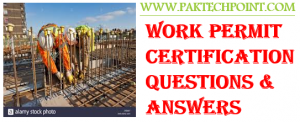This article is about Work Permit Certification Questions. What is Work permit system. Saudi Aramco Work Permit System. Question Answers work permit. and focusing to the engineers, technicians and supervisors. You will find lot of documents related to this article. Just navigate our website www.paktechpoint.com and find more articles. Please! Do not forget to subscribe our You tube channel also. Thanks in Advance.
PLEASE SUBSCRIBE OUR PAKTECHPOINT YOUTUBE CHANNEL
Work Permit Certification (WPR) Questions & Answers
1-Who must sign a work permit issuer or receiver certificate?
a-The designated representative.
b-The issuer or receiver.
c-The superintendent of issuer or receiver.
d-The foreman of the issuer or receiver.
2-For how long is a work permit issuer or received certificate valid?
a- 1 year.
b- 6 months.
c- 2 years.
d- 90 days.
3-What are two important reasons for using work permit?
a-To communicate and control work.
b-To track contractors and mange emergencies.
c-To designate representatives and communicate.
d-To track work hours and contractor names.
4-Why do we use work permits in hazardous areas?
a-To identify a designated representative.
b-To identify receivers.
c-To identify hazards and precautions.
d-To check expired
certification.
5-For what conditions are work permits issued?
a-Specific work ar a specific location.
b-General equipment at small work sites.
c-General work at a general location.
d-Specific tools at a general location.
6-What is listed on a work permit?
a-OSHA safety precautions.
b-Minimum safety precaution.
c-Maximum safety precaution.
d-Government safety precaution.
7-Why do we use the work permit system?
a-To monitor contractor work hours.
b-To renew certificates.
c-To prevent incidents.
d-To log incidents.
8-What does a restricted area require?
a-That extensions are short term.
b-That work permits are issued.
c-That certificates are issued.
d-That receivers respond to emergencies.
9-Whan can a work permit issuer decide that a work permit is not needed in a restricted area?
a-When he decides the work is low risk.
b-When the work is cols work.
c-When a joint site inspection is not needed.
d-Never! They are always required in restricted areas.
10-Select the choice where every item is a restricted area.
a-Pump stations, sewage plants, wells.
b-Wells, loading piers, dining halls.
c-Communications buildings, wells, fenced areas.
d-Wells, office building, welding shops.
11-Examples of low risk work are:
a-Cold work light work and non-destructive testing.
b-Spray painting water-washing and turbine work.
c-Sweeping visual inspecting and minor cleaning.
d-Brush painting, abrasive blasting and sweeping.
12-A specific area is not normally categorized as restricted. Who makes the final decision whether this area should be categorize as restricted?
a-Area superintendent.
b-GI 2.100.
c-Loss prevention.
d-Department Manager
13-Why is a designated representative sometimes used?
a-Too many safety problems were found.
b-The receiver did not come to work.
c-The gas tester found high LEL reading.
d-The issuer may be busy and need help.
14-What are the receivers main responsibilities?
a-Being the designed main representative.
b-Responding to operational emergencies.
c-Filling in for the issuer when the issuer must leave.
d-Complying with safety precautions and signing the permit.
15-An issuer has which responsibilities?
a-Issues and receives work permits.
b-Defines precautions and stands in for the receiver
c-Supervises the work crew and signs the permit.
d-Defines safety precaution and signs the work permit.
16-A receiver must be what?
a-A qualified engineer.
b-A senior contractor manager.
c-A senior craftsman.
d-A designated repersentive.
17-What is a work permit issuer responsible for?
a-Extending
certificates.
b-Nothing once he issues a permit.
c-The receivers action.
d-Equipment or a work area.
18-What can the designated representative do?
a-Accept the receivers responsibilities.
b-Sign the work permit.
c-Inspect the work site.
d-Authorize the receiver to leave.
19-What joint responsibility do issuers and receivers share?
a-Naming the designated representative.
b-Taking gas tests.
c-Doing the work.
d-Safety at the work site.
20-Why is it important that the issuer tell the receiver about safety hazards he may find at a job site?
a-The receiver does not read the work permit.
b-The receiver must respond to emergencies.
c-The receiver may not have worked in the area before.
d-The receiver must take gas test.
21-What two things must the issuer do before issuing a work permit?
a-Close the work permit and check the receivers certificate.
b-Check the recivers certifcate and get countersignatures.
c-Renew certificates and get countersignatures.
d-Provide first aid and assign a fire watch.
22-Who goes on the joint site inspection?
a-The issuer and gas tester.
b-The issuer and the area foreman.
c-The issuer and receiver.
d-The receiver and gas tester.
23-What two things must the receiver do before receiving a work permit?
a-Read the permit and agree to air condition.
b-Take gas tests and check scot air packs.
c-Extend the permit and take gas tests.
d-Train the fire watch and renew the permit.
24-Where must the receiver keep the work permit after it is issued?
a-With a senior crewmember.
b-Dismayed at the jobsite or in his possession.
c-In the control room.
d-Within 75 feet of the work site.
25-When can a receiver leave the job site?
a-When all hot work is stopped.
b-When gas tests read 0.0% LEL.
c-When the issuer has given him permission.
d-Before confined space entry.

